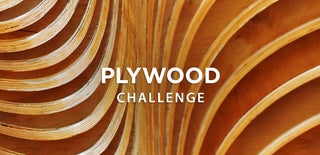Introduction: Geometric Plywood Pendant Light
This is a short instructable which can hopefully serve as an idea generator for anyone who reads it.
This pendant light, which is easily adaptable to be a "lamp shade" only, plays on the simple natural beauty of plywood, particularly the exposed lamina. The sharp geometry further plays to the plywoods strengths as, due to it's cross laminations, the angles of the "arms" do not have to follow a grain, something that thin natural timber may struggle a little with.
I've said it before... I'd eat birch plywood, if I could. It's a fantastic material. The clean and crisp laminations, actually accentuate sharp geometries, and ease curved geometries. It's really quite beautiful.
This is a good "scrap" project, perfect for using up funny shaped leftover plywood pieces.
This is an old fashioned more "blunt force" antidote to delicate thin lazercut lamp shades!
Supplies
The Plywood
6 / 12 / 15 / 18mm Birch Plywood. I used 15mm scraps from a previous project.
The Glue
I use Titebond Original - Any wood glue will do!
The Finish
A can of spray Lacquer / Tin of Varnish / Whatever / Nothing
Some Screws
16 no. Small Brass Screws ~ 20mm Long (from your screw tin!)
Cable
I used Braided Twisted 3 Core Cabling
The Lamp Holder
I salvaged from an old light fixture, but literally any lamp holder can be adapted, as the plywood element is really just a lampshade.
The Light
I sued an Edison Style Warm Light LED
Tools
Band saw, Scroll saw or jigsaw - for cutting out the plywood. I used a small band saw. Would need to be very careful with splintering and tearout if using a jigsaw, but it would be possible!
Sandpaper!
& Thats about it, beyond maybe a small drill bit and screwdriver.
Step 1: The Design
The Design
After starting by "taking a pencil for a walk" - I settled on a rough shape and idea, an 8 armed simple geometric shape, that I'd hope would cast some nice shadows, and play nicely with an LED Edison type Bulb. I find for certain projects, the drawing is a "rough steer", particularly small projects like this, where in many ways, the prototype becomes the drawing.
Using plywood means you are not constrained by plank widths and grain expected of timber. It is stable and strong.
Step 2: The Template & the Cutting
Broadly working from the original drawing, I transferred the geometry onto a piece of plywood, and cut it out using a bandsaw.
This was my template for the other arms, which were satisfyingly traced. Using a template means that each arm is precisely the same (within reason!)
Obviously using any kind of saw, wont leave a perfectly clean edge, so I cleaned these up reasonably efficiently using a Dremel sanding drum, and then some hand sanding using 120 grit sandpaper.
I could have spent longer on this, but there is something inherently special about plywood, that can stand up to being "not perfect", but still look perfect!
Step 3: Cutting Circles
I have 2 circles of plywood, with a different inner diameters. The upper inner diameter, should be sized to suit the lamp holder.
There are lots of guides online about cutting perfect circles by various means, including a great instructable.
https://www.instructables.com/How-to-Cut-Circles-4...
However, for these circles, I used the following simple method:
- Mark inner and outer diameter on plywood, using a compass.
- Cut inner circle, using a suitably sized hole saw, on either a drill press or hand drill.
- Cut outer circle as close as possible by eye to the line. I was not worried about perfection on the outer circle, as I knew if it was "close enough" it would be hidden by the arms.
For both rings, I drilled 8 no. holes in each, to receive brass screws, to hold the arms in place. With enough clamps, and enough patience, these would not be required, however this enabled me to "let the screws do the clamping" ensuring that this was a "single-session" project!
Step 4: Assembly & Finish
The images show the gist of the assembly.
At the top the arms are friction fitted and glued...and screwed. At the bottom, the arms are glued and screwed with a single brass screw. I worked my way around the top and bottom rings in an "opposite arms" sequence.
Note, the screws are really just there to avoid the requirement for clamping, particularly as they are funny shapes which could be difficult to clamp.
WIRING
I think the safest thing to say here is to follow appropriate instructions and regulations, particularly with wiring in pendant lighting, which will ultimately be on a home lighting circuit. The physical wiring of the lamp holder is intuitive and straightforward, and for some of us, like wiring a plug, it is ingrained in our muscle memory. If not, there are lots of instructables...like this one. https://www.instructables.com/Wiring-Sockets/
FINISHING
2 coats of spray laquer, while suspended, and the jobs a good one. Any finish would work on this, even NO finish.
Step 5: Epilogue: a Geometric Plywood Pendant Light
There it is, a simple quick, one-day project, highlighting the beauty of plywood. The other wonderful thing, is, it is so low cost, and relatively low effort, that you will not feel guilty, if you get sick of it, and decide to upgrade to a nicer light fitting.
As you can see, the natural tone of the plywood, works harmoniously with "warm-light" , it enhances the saturation level of the plywood
On another note, a single sheet of Baltic Birch Plywood, cut in 4, is readily handleable and storable, and is great to have in the waiting, for impromptu small projects like this.

Participated in the
Plywood Challenge













